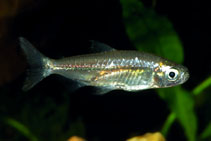| Family: |
Alestidae (African tetras) |
| Max. size: |
10.6 cm TL (male/unsexed) |
| Environment: |
pelagic; freshwater; pH range: 6.5 - 7.5; dH range: 10 - 25, |
| Distribution: |
Africa: widely distributed in the Congo basin (Ref. 42032). Also found in the Bénoué, Chad (Ref. 81279), Cross (Ref. 80290, 81279) and the Zambezi River (Ref. 5331, 80290). Report from Lake Tanganyika (Ref. 80290) needs confirmation; in the Lukuga River only known downstream of Niemba (Ref. 36901, 42032). Report from the Cubango/Okavango in Angola (Ref. 5331) unconfirmed (Ref. 120641). |
| Diagnosis: |
Dorsal spines (total): 0-0; Dorsal soft rays (total): 10-10; Anal spines: 0-0; Anal soft rays: 17-22. Diagnosis: lateral line always complete, 24-27 (Ref. 80290) or 27-30 (Ref. 81279) lateral line scales. Anal fin with 3 unbranched and 15-18 (Ref. 80290) or 14-19 (Ref. 81279) branched rays. 10-15 (Ref. 80290) or 10-14 (Ref. 81279) gill rakers on lower part of first branchial arch. 6/8 premaxillary teeth; fins colorless or, at most, pinkish; tip of dorsal fin hyaline (Ref. 2880, 81279), no black apical tip (Ref. 80290). Scales of flank with melanophores concentrated on basal margin (Ref. 80290).
Description: body slender; body depth 26-30% and head length 26-28% of SL (Ref. 80290). Body height 3.2-4x SL and head length 3.45-3.8x SL (Ref. 2880, 81279). Mouth terminal, lower jaw not prominent, its depth about 2x that of upper jaw (Ref. 80290). Premaxilla with 3 teeth in outer row each bearing 5 cusps, 4 teeth in inner row each bearing 5-7 cusps; dentary with 4 teeth in outer row each bearing 5-7 cusps, a conical monocuspid tooth at symphysis posterior to outer row teeth; lateral line complete, 25-29 tubes, ultimate canal-bearing scale terminal (Ref. 80290). Sexual dimorphism affecting anal-fin shape in adult males (Ref. 2880, 81279).
Coloration: body silvery with glossy, brilliant lateral stripe; lateral stripe starting behind the operculum, progressively enlarging and ending at the origin of the caudal fin and showing as black, posteriorly broadened band after preservation in formalin; lateral-line scales blackish at base, those on sides less so (Ref. 2880, 42032, 80290, 81279). Fins generally hyaline to moderately dusky (Ref. 80290), greyish without black marks (Ref. 2880, 42032, 81279). Adipose fin with pigmented margin in larger individuals (Ref. 80290). |
| Biology: |
Affinities: M. humilis is most similar and possibly conspecific with M. stormsi Boulenger, 1902, and M. sardina Poll, 1938; apart from coloration, it is distinguished from latter two species on the basis of slight differences in overlapping features (see Ref. 80290). |
| IUCN Red List Status: |
Least Concern (LC); Date assessed: 13 August 2019 Ref. (130435)
|
| Threat to humans: |
harmless |
Source and more info: www.fishbase.org. For personal, classroom, and other internal use only. Not for publication.

